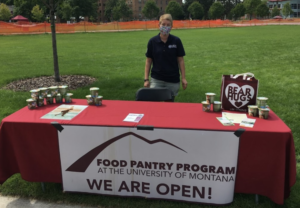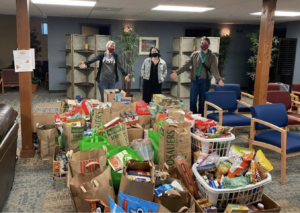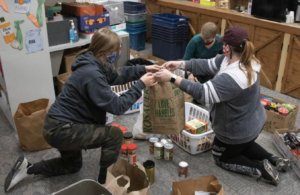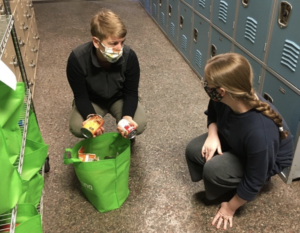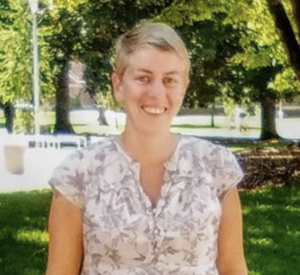Growing the University of Montana Food Pantry: A different kind of food service by Hilary Rosa
Pre-service
I grew up in a military family, and my mother would continuously emphasize the value of public service. During my teenage years, I dreamt of joining the Peace Corps, but I ended up taking quite a detour after high school. Many years later, a summer internship at the Gallatin Valley Food Bank led me to consider instead a position with AmeriCorps.
Before my position as an AmeriCorps VISTA, I had worked in the food service industry for over a decade- restaurants, mostly, but some retail kitchens and catering gigs as well. I had a lot of experience cooking professionally, but no real experience in any other job-setting.
My decision to attend college was motivated by a desire to do more socially-oriented work. The more I learned about what this work entails, the more I felt that serving with AmeriCorps would be the best practical way for me to transition from the service industry to the nonprofit world: I would develop valuable skills, expand my professional network, and have some level of job-security- all while giving back to my community.
I was on track to finish my undergraduate degree in May of 2020 when Covid-19 hit. I knew I would be entering into a rough job market, and I felt underqualified for a job in the nonprofit sector. The decision to serve with AmeriCorps became clear in my mind. My partner and I packed our belongings, moved to Missoula, and I began a new chapter at the University of Montana Food Pantry.
Service
Early on in my service, I developed a needs assessment survey for students in quarantine as result of exposure to Covid-19. Since then, the UM Food Pantry has coordinated with UM Dining Services to supplement requests for food and personal care products.
Throughout fall semester, I worked to promote the pantry and help qualifying students enroll in the Supplemental Nutrition Assistance Program (SNAP). I also had many opportunities to network with other organizations around Missoula, as well as campus food pantries across the state, to address basic needs insecurity, share resources, and advocate for students.
In October, I worked with Matz Family Chiropractic Clinic to sponsor a food drive which resulted in over 2,000 lbs. of donations to the UM Food Pantry. Then in November, we partnered with Missoula Food Bank & Community Center, Grizzly eSports, and other UM departments to raise donations for the 21st annual Can the Cats food drive. Helping to coordinate two successful food drives back-to-back was very exhausting, but also very rewarding!
When Thanksgiving arrived, we prepared and distributed 45 holiday meal kits to UM students and community members. When fall semester finally came to an end and traffic slowed, we took some time to get organized, revisit our strategic plan, and prepare for another semester.
Now that spring is upon us, I will be planning a virtual fundraising event to celebrate the 2nd Anniversary of the UM Food Pantry. I will also be working closely with the UC Gardens to ensure that the veggies grown on campus are made available to pantry customers. This budding partnership will increase student involvement in the pantry, raise awareness of our services, and reduce food waste on campus.
Even though I feel as though I am finally making a difference, I have to acknowledge the incredible groundwork that was laid for me by the previous VISTA, Sarah; indeed, all of the progress that I have made has been infinitely easier as a result of her hard work and diligence. When I actually stop to think about it, I am amazed by what she was able to accomplish for the pantry in the span of just one year!
Lessons
While this experience has certainly provided me with many opportunities to network and develop professionally, I know that this work is about so much more than my personal journey. Since the onset of Covid-19, food insecurity has increased both globally and locally. According to #RealCollege survey data, 42% of UM students experienced food insecurity and 55% experienced housing insecurity in 2019 (this is on par with the national average: 45% and 56%, respectively), and I worry that these figures will increase as a result of Covid-19. These numbers are unacceptable, and yet only 15% of students experiencing basic needs insecurity utilize resources like the UM Food Pantry or SNAP benefits.
The UM Food Pantry serves over 300 people. We distribute 1,736 lbs of food and hygiene products through 85 in-person visits per month, on average- but the problem of food insecurity persists, and there is much more work to be done.
Now that my term of service is nearly halfway over, I am already contemplating another year. I have come to know many of our customers and their personal stories: struggles with income, balancing schedules and responsibilities, homelessness, and Covid-19. I have experienced firsthand the immense support from volunteers, student groups, and departments across campus, and I have come to understand just how much this program means to UM students and their families. I feel very much invested in the future of the UM Food Pantry, and I just hope that my commitment to service will do justice to the service(s) provided by this organization.
Transitioning from work in retail kitchens to the University of Montana Food Pantry has seemed very natural- probably because both lines of work revolve around feeding people. However, the feeling I get after a day’s work in the pantry is very different from the exhaustion of standing over a hot grill: I see less waste and experience much more gratitude. I believe that food is a great medium for bringing people from all walks of life together. Nutritious food is so fundamental to quality of life, and I am just tickled that my job involves improving access for those who need it most. This brand of food service certainly feels like home.
 Blog Posts
Blog Posts 